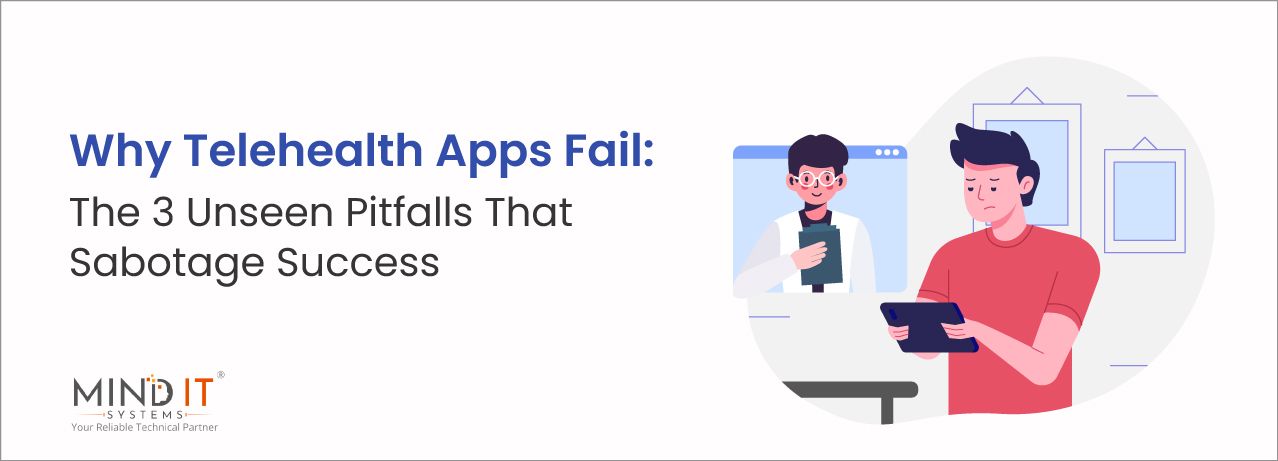
Why Telehealth Apps Fail: The 3 Unseen Pitfalls That Sabotage Success
Introduction
Building a telehealth app? It’s a promising venture, but tough to succeed. Here’s the catch – 53% of health apps are uninstalled within 30 days.
The telehealth market is booming, projected to hit $186.41 billion in 2025, with expectations of reaching $791.04 billion by 2032, reflecting a compound annual growth rate (CAGR) of 22.9% during the forecast period (Source: Fortune Business Insights). Yet, a surprising number of apps fail to retain users, deliver consistent performance, or meet compliance standards.
So, why do telehealth apps fail, even with strong demand and investment? That’s precisely what we’ll unpack here in this blog.
Let’s dive in.
Why Telehealth Apps Fail: The 3 Unseen Pitfalls You Cannot Ignore
Despite investment and promising tech stacks, many apps sink because of avoidable blind spots. Let’s explore the 3 biggest pitfalls and how to dodge them.
Pitfall #1: Complex Navigation Drives Users Away
First impressions matter; you have seconds to make one in digital healthcare. If users find themselves lost in a maze of menus or overwhelmed by cluttered dashboards, they won’t stick around.
Stats That Matter:
- 70% of users stop using health apps within 100 days, with poor usability being one of the leading causes (Source: Journal of Medical Internet Research, 2024)
- Approximately 40% of higher drop-off happens, estimated in the first 5 minutes, if users don’t get proper onboarding, according to the User Guiding survey report (2024).
What’s Going Wrong?
- Cluttered dashboards with irrelevant features
- A “one-size-fits-all” design approach for very different user roles (patients, doctors, and admin)
- Inconsistent UI/UX that kills trust
The Fix:
- Design role-specific dashboards (what a provider sees vs. a patient)
- Ensure consistency in UI patterns (icons, fonts, buttons)
- Build simple, engaging onboarding journeys with tooltips and smart walkthroughs
Is Your Telehealth App Missing the Mark?
Build a robust platform that users will rely on
Pitfall #2: Poor Performance Undermines Trust
In remote care delivery, speed isn’t just nice to have—it’s a matter of trust and safety. Once users understand how to use your app, their next expectation is reliability. Lagging video, app crashes, or delays during critical care sessions aren’t just frustrating—they’re deal-breakers.
Shocking Numbers:
- 25% of users leave an app if it takes over 5 seconds to load, as per Google User Experience Benchmark.
- 88% of patients say a crash during a telehealth session makes them unlikely to return, according to a survey report by Deloitte.
The Pain Points:
- Lag during live consultations
- Frequent crashes after app updates
- Poor optimization for low-bandwidth networks
- Incompatibility with older devices or multiple platforms
The Fix:
- Optimize for low-bandwidth users with adaptive video quality
- Regularly test across different networks and devices
- Use cloud-native architecture for scalability and resilience
- Automate load testing to avoid post-deployment surprises
Pitfall #3: Security Lapses Lead to User Loss
You’ve made it easy to use. It runs fast. But does it protect patient data and meet regulatory standards? If not, the fallout could be legal, financial, and reputational.
Security and compliance aren’t just IT concerns—they’re business imperatives, any slip-ups can push users away.
Security Slip-Ups Result in:
Loss of Personal Data: Patient data, including medical records and personal identifiers, is not just sensitive but highly sacred. A single breach can trigger HIPAA violations, lawsuits, and loss of credibility.
Cyberattacks: Malware or ransomware attacks can cause system downtime, data loss, and potentially halt operations, undermining user confidence and trust in the platform.
Complicated Payment Process: Complex or poorly designed payment flows can create security gaps, increasing the risk of breaches and frustrating users.
Why It Matters: The Facts
- According to the U.S. Department of Health and Human Services Office for Civil Rights (OCR), 725 healthcare data breaches were reported in 2023, exposing over 133 million records. The average cost per breach rose to $10.93 million, a 53.3% increase from previous years, making healthcare the most expensive industry for cyberattacks.
- 720 healthcare data breaches were reported to OCR in 2024, impacting approximately 186 million records. The average cost per breach slightly declined to $9.77 million but remained nearly double the cross-industry average of $4.88 million.
- The healthcare sector is expected to face escalating risks in 2025, with cybersecurity experts warning of increased ransomware and phishing attacks, especially targeting telehealth platforms.
These reports highlight the growing concern around healthcare data breaches, with 2023, 2024, and 2025 showing increasing severity, both in the number of breaches and associated costs.
The Fix:
- Balance security with usability, such as implementing biometric logins or single sign-ons.
- Use standards like FHIR (Fast Healthcare Interoperability Resources) for seamless EHR integration.
- Schedule regular third-party compliance audits to ensure ongoing adherence.
How to Future-Proof Your Telehealth App?
Knowing the issues is just step one. Here’s how to ensure your platform performs, delights, and scales:
Design with Empathy:
Create simple, clean layouts for every user role. Use feedback loops and A/B testing to continually improve usability.
Prioritize Speed and Stability:
Build with performance in mind. Use caching, CDNs, and lightweight code to improve responsiveness.
Commit to Compliance from Day One:
Include legal experts in your dev cycle. Ensure your app evolves alongside regulatory shifts and industry standards.
Embrace AI in Healthcare:
From predictive analytics to symptom checkers, AI in healthcare is transforming telemedicine—just be sure it aligns with clinical and legal expectations.
Your Next Move?
If you’re serious about scaling a telehealth app that patients trust, providers embrace, and regulators approve, start with the basics.
Audit what you’ve got. Rethink your design. Prioritize performance. Build compliance into your DNA.
Partner with the Right Team
You’ve identified the gaps. You know what’s at stake. Now it’s time to act, with the right partner by your side.
At Mind IT Systems, we specialize in healthcare app development that truly works for patients, providers, and regulators. Our domain expertise ensures your solution is not only technically sound but also user-friendly, scalable, and compliant from day one.
Whether you’re building from scratch or improving an existing platform, we help you design intuitive, role-based UX; ensure smooth performance in low-bandwidth environments; meet compliance standards like HIPAA, GDPR, and EHR interoperability; and integrate smart features such as AI, remote monitoring, and secure video consults.
Don’t let unseen pitfalls derail your progress. Partner with a team that understands healthcare technology inside and out.
Get Expert Help with Your Telehealth App
Partner with professionals who know how to build, scale, and secure telehealth solutions.
Frequently Asked Questions
1. How do I reduce user drop-off in my telehealth app?
Ans: Simplify onboarding, ensure fast load times, and offer a clean, role-specific interface from day one.
2. Is HIPAA the only compliance I need to worry about?
Ans: No. Depending on your market, you may also need to meet GDPR (General Data Protection Regulation), PIPEDA (Personal Information Protection and Electronic Documents Act), or cross-border licensure requirements.
3. How can I ensure app performance across devices?
Ans: Use cross-platform testing tools, support older OS versions, and design for low-bandwidth environments.
4. What makes a telehealth app “future-proof”?
Ans: Adaptability. That means real-time updates, modular architecture, strong EHR integration, and flexible compliance models.
5. Can telehealth apps fail due to the lack of scalability?
Ans: Yes, if a telehealth app isn’t built with scalability in mind, it can break down as the user base grows or when more complex features are added. Scalability is essential for accommodating increasing user loads and evolving technological demands.
Share this post
About the Author

Sujoy Roy
(Head – Digital Marketing)
From my teenage time, I had a quench to solve problems and loved leadership. Starting my career in relation management, ignited my passion for managing people. While managing I realized technology needs to be incorporated to keep pace with the changing world & do my work efficiently.

